Natural Ventilation in Vernacular Architecture of Sistan, Iran; Classification and CFD Study of Compound Rooms
Abstract
:1. Introduction
- Managing natural environment, protecting its sources and ecological system.
- Managing financial aspects, reducing costs and increasing values.
- Improving social responsibility to improve the quality of life and equality among individuals and groups.
2. Literature Review
3. Materials and Methods
- Qualitative phase: In this phase, vernacular architecture of Sistan, its aspects and elements were studied through a comprehensive literature review, which was discussed in previous manuscript [12], a series of interviews with local masons and direct field studies carried out across the whole region of Sistan. The interviews were a series of informal conversations between authors and native masons, which is a dying profession, with only few who are still alive. They are the living history of the region’s architecture and are commonly known and greatly respected in academic society of architects. Some of the questions that were asked during these interviews include: “how did you supply the necessary materials?”, “how did you used to build the roofs without any scaffolds?”, “how did you make sure that ventilator openings would work correctly?”, “how did you choose the right openings for each house, etc. This section resulted in identification and classification of different compound room types.
- Quantitative phase: Parameters involved in natural ventilation were detected and ventilation simulations were carried out on all three identified compound room types using Gambit™ and Ansys Fluent™ software. There were no existing similar studies in the field to refer to and the authors have used an original approach to achieve their goal in this phase.
- Verification phase: Considering the necessity to verify the results of the CFD simulations [31], the results were confirmed, using an empirical research method and direct measurements in a period of four months using a digital anemometer (June to September 2015). In the end, according to the verifications achieved in the third phase, the simulation results were confirmed and concluding guidelines were educed (Figure 1).
4. Sistan
5. Sistan’s Vernacular Architecture
5.1. Roofs
5.2. Ventilator Openings
5.3. Walls
6. Defining Different Room Types for Simulation
7. Computational wind Engineering (CWE)
- CFD simulation of pedestrian-level wind conditions around buildings;
- CFD simulation of natural ventilation of buildings; and
- CFD simulation of Wind-driven rain in building façade.
8. Wind Behavior in Defined Room Types
|
|
8.1. Wind Behavior in Compound Room Type 1
8.2. Wind Behavior in Compound Room Type 2
8.3. Wind Behavior in Compound Room Type 3
9. CFD Validation with Direct Empirical Measurements
10. Conclusions
- ▪
- Compound room type 1: Air flows through all the spaces that are used by the dwellers and it is only under the ceiling that wind speed drops to almost 0 m/s. This type has the widest leeward area which is caused by its elongation against the prevalent wind. This is the perfect area to build a terrace. Wind behavior analysis in this type shows that by extending the elongation on NE/SW direction and building several rooms of this type in this direction, off wind tranquil area down the rooms grows wider and wider.
- ▪
- Compound room type 2: There is no ventilation between the two parts of this room (just like room type 1), but ventilator elements that are used in both parts of the room provide an acceptable level of air flow in all the spaces that are used by the dwellers. Turbulences in the leeward area cause the entrance door to act as an entry point for wind which can be a great problem, especially during the dust storms. Large surface of the door and the fact that most of the time its not properly sealed causes it to act as an entry point for contamination and dust; therefore, necessary precautions should be made to alleviate this problem. Off wind leeward area in this type is smaller than the one in type 1 and wind turbulences happen near the house mass. Due to these turbulences, it is hard to use the terrace in this room type, especially during high speed winds.
- ▪
- Compound room type 3: This is the only type that two parts of the room do not act as separate cells and there is a wind flow between them. Wind flow is stronger in the northern part due to its Darichehs; therefore, it is usually used as living room. Wind behavior analysis shows that the wind enters the room through the doors which causes several problems similar to the problems in room type 2. In this type, window acts as a suction point and drives out the wind. Therefore, it can be opened for ventilation even during high speed winds. The area in front the room in southwestern part is parallel to prevalent wind direction and experiences high wind speed (up to 10 m/s) which makes it unsuitable for dwellers traffic; therefore, this paper suggests that room type 3 should be combined with other types with a perpendicular orientation against the wind. Off wind leeward area down this room type is pretty small and considering the doors position and dwellers traffic, it is practically unusable.
- ▪
- Using room type 3 shapes alleys that are parallel to prevalent wind direction in the overall pattern of the villages. By building new houses on two sides of these alleys, they turn into canals that channel the wind through the village with an extremely high speed. This problem can be averted by combining this room type with other type,
- ▪
- Parts of the room types that use all three ventilator elements (Kolak, Surak and Dariche) with an appropriate dispersion pattern, have the best ventilation performance and are usually used as houses’ main space. Therefore, room type 1 has the best ventilation performance because of appropriate dispersion of openings and appropriate airflow all over the room.
- ▪
- In room type 3, southeastern half of the room has a weak ventilation performance compared to the other types and as field studies show, it is usually used as service room. This half of room type 3 is especially suitable for winter, as it is built on the sunlight facing, southeastern part of the house and has no Darichehs.
- ▪
- Openings’ dimensions in Sistan vernacular architecture causes the wind to enter the room with the same speed as the regions prevalent wind. Native people block portions of the opening in response to the wind speed to reach the best ventilation performance in their houses. This paper proposes the same dimensions to be used in new buildings’ openings in northwestern walls and suggests that builders refrain from using large windows (as is the case for majority of new constructions in the region).
- ▪
- Studies show that off wind leeward areas behind the rooms’ parts with Kolak is wider than the parts without it.
- ▪
- Considering the turbulence area down the room type 1, new constructions should happen in a 16 m distance from this room type (four times the room length in prevalent wind direction), where the wind behavior returns to normal.
- ▪
- Considering the fact that, in most cases, doors of these room types act as an exit point for the wind and leaving them open, can cause some problems, this paper suggests the builders to use the type of doors with some openings on their surfaces.
11. Outlook for Future Researches
Acknowledgments
Author Contributions
Conflicts of Interest
References and Notes
- Suleiman, S.; Himmo, B. Direct comfort ventilation. Wisdom of the past and technology of the future (wind-catcher). Sustain. Cities Soc. 2012, 5, 8–15. [Google Scholar] [CrossRef]
- Chenari, B.; Dias Carrilho, J. Gameiro da Silva, M. Towards sustainable, energy-efficient and healthy ventilation strategies in buildings: A review. Renew. Sustain. Energy Rev. 2016, 59, 1426–1447. [Google Scholar] [CrossRef]
- Pérez-Lombard, L.; Ortiz, J.; Pout, C. A review on buildings energy consumption information. Energy Build. 2008, 40, 394–398. [Google Scholar] [CrossRef]
- Knights, B. Clean Technology and the Environment; Kirkwood, R.C., Longley, A.J., Eds.; Chapman & Hall: London, UK, 1994; 350p, ISBN 0-7514-0037-8. [Google Scholar]
- Abro, R.S. Recognition of passive cooling techniques. Renew. Energy 1994, 5, 1143–1146. [Google Scholar] [CrossRef]
- Fathy, H.; Shearer, W.; Sultan, A.-E.-R.A. Natural Energy and Vernacular Architecture: Principles and Examples with Reference to Hot Arid Climates; University of Chicago Press: Chicago, IL, USA, 1995. [Google Scholar]
- Foruzanmehr, A. People’s perception of the loggia: A vernacular passive cooling system in Iranian architecture. Sustain. Cities Soc. 2015, 19, 61–67. [Google Scholar] [CrossRef]
- Winiarski, D.; Shankle, S.; Hail, J.; Liu, B.; Walker, A. The Business Case for Sustainable Design in Federal Facilities: Appendix B: Energy and Construction Cost Estimates; Pacific Northwest National Laboratory and National Renewable Energy Laboratory: Richland, WA, USA, 2003.
- Khalili, M.; Amindeldar, S. Traditional solutions in low energy buildings of hot-arid regions of Iran. Sustain. Cities Soc. 2014, 13, 171–181. [Google Scholar] [CrossRef]
- Foruzanmehr, A.; Vellinga, M. Vernacular architecture: Questions of comfort and practicability. Build. Res. Inf. 2011, 39, 274–285. [Google Scholar] [CrossRef]
- Memarian, G.; Mohammadmoradi, A.; Hosseinalipour, S.M.; Heidari, A.; Abdi Ardekani, H. Vernacular Techniques of Using Wind in order to Rehabilitate the Identity of Contemporary Rural Housing Architecture of Sistan. Int. Res. J. Appl. Basic Sci. 2015, 9, 1287–1294. [Google Scholar]
- Sahebzadeh, S.; Heidari, A.; Kamelnia, H.; Baghbani, A. Sustainability Features of Iran’s Vernacular Architecture: A Comparative Study between the Architecture of Hot–Arid and Hot–Arid–Windy Regions. Sustainability 2017, 9, 749. [Google Scholar] [CrossRef]
- Salighe, M. Considering the wind in construction of Zabol citys physical body. Geogr. Dev. Iran. J. 2004, 2, 109–122. [Google Scholar]
- Fazelniya, G.; Kiani, A.; Khosravi, M.A.; Bandani, M. Investigation Rural Vernacular Pattern, on the Contrary windy sands, Case Study: Tambaka village of Zabol. J. Hous. Rural Environ. 2012, 30, 3–16. [Google Scholar]
- Mirlotfi, M.r.; Tavakoly, M.; Bandani, M. The comparative study of the geographical directions of rural housing and energy consumption in Sistan. J. Hous. Rural Environ. 2012, 31, 39–52. [Google Scholar]
- Hajdukiewicz, M.; Geron, M.; Keane, M.M. Formal calibration methodology for CFD models of naturally ventilated indoor environments. Build. Environ. 2013, 59, 290–302. [Google Scholar] [CrossRef]
- Chen, Q. Ventilation performance prediction for buildings: A method overview and recent applications. Build. Environ. 2009, 44, 848–858. [Google Scholar] [CrossRef]
- van Hooff, T.; Blocken, B. Coupled urban wind flow and indoor natural ventilation modelling on a high-resolution grid: A case study for the Amsterdam ArenA stadium. Environ. Model. Softw. 2010, 25, 51–65. [Google Scholar] [CrossRef]
- Calautit, J.K.; Hughes, B.R. Measurement and prediction of the indoor airflow in a room ventilated with a commercial wind tower. Energy Build. 2014, 84, 367–377. [Google Scholar] [CrossRef]
- Kobayashi, T.; Sandberg, M.; Kotani, H.; Claesson, L. Experimental investigation and CFD analysis of cross-ventilated flow through single room detached house model. Build. Environ. 2010, 45, 2723–2734. [Google Scholar] [CrossRef]
- Montazeri, H.; Azizian, R. Experimental study on natural ventilation performance of one-sided wind catcher. Build. Environ. 2008, 43, 2193–2202. [Google Scholar] [CrossRef]
- Montazeri, H.; Montazeri, F.; Azizian, R.; Mostafavi, S. Two-sided wind catcher performance evaluation using experimental, numerical and analytical modeling. Renew. Energy 2010, 35, 1424–1435. [Google Scholar] [CrossRef]
- Mora-Pérez, M.; Guillen-Guillamón, I.; López-Patiño, G.; López-Jiménez, P. Natural Ventilation Building Design Approach in Mediterranean Regions—A Case Study at the Valencian Coastal Regional Scale (Spain). Sustainability 2016, 8, 855. [Google Scholar] [CrossRef]
- Liu, S.; Huang, C. Optimization of Natural Ventilation of “Yinzi” Dwellings in Western Hunan Based on Orthogonal Experiment and CFD. Buildings 2016, 6, 25. [Google Scholar] [CrossRef]
- Tate, G.P. Seistan: A Memoir on the History, Topography, Ruins, and People of the Country; Superintendent Government Printing: Calcutta, India, 1977.
- Davtalab, J. Documentation of “Qale-no” village of Sistan. In Organization of Cultural Heritage, Handicrafts and Tourism, Document Archieves; Organization of Cultural Heritage, Handicrafts and Tourism: Zabol, Iran, 2003. [Google Scholar]
- Ali Sargazi, M. Sustainable Development and its Concepts in Rural Residential Spaces of Sistan, Iran. Eur. Online J. Nat. Soc. Sci. 2014, 3, 98. [Google Scholar]
- Yarmohammadi, H.; Akrami, G.; Dahi, S. A Qualitative and Quantitative Assessment of different kinds of current Cooling Systems in Rural Residential Buildings Case Study: Khoor, Khorasan, Iran. J. Hous. Rural Environ. 2013, 31, 33–50. [Google Scholar]
- Saadatian, O.; Haw, L.C.; Sopian, K.; Sulaiman, M. Review of windcatcher technologies. Renew. Sustain. Energy Rev. 2012, 16, 1477–1495. [Google Scholar] [CrossRef]
- Haghighi, A.P.; Golshaahi, S.S.; Abdinejad, M. A study of vaulted roof assisted evaporative cooling channel for natural cooling of 1-floor buildings. Sustain. Cities Soc. 2015, 14, 89–98. [Google Scholar] [CrossRef]
- Blocken, B. 50 years of Computational Wind Engineering: Past, present and future. J. Wind Eng. Ind. Aerodyn. 2014, 129, 69–102. [Google Scholar] [CrossRef]
- Rashki, A.; Kaskaoutis, D.G.; Rautenbach, C.J.D.; Eriksson, P.G.; Qiang, M.; Gupta, P. Dust storms and their horizontal dust loading in the Sistan region, Iran. Aeolian Res. 2012, 5, 51–62. [Google Scholar] [CrossRef]
- Tavoosi, T.; Salighe, M.; Safarzaei, N. Study of Wind direction and parameters and its role in Iran’s Sistan Dust Storm. Geogr. Sustain. Environ. 2012, 2, 19–30. [Google Scholar]
- Moghaddamnia, A.; Ghafari Gousheh, M.; Piri, J.; Amin, S.; Han, D. Evaporation estimation using artificial neural networks and adaptive neuro-fuzzy inference system techniques. Adv. Water Resour. 2009, 32, 88–97. [Google Scholar] [CrossRef]
- Meteoblue. Climate Zabol—Meteoblue 2015. Available online: https://www.meteoblue.com/en/weather/forecast/modelclimate/zabol_iran_1113217 (accessed on 22 February 2017).
- Alizadeh-Choobari, O.; Zawar-Reza, P.; Sturman, A. The “wind of 120 days” and dust storm activity over the Sistan Basin. Atmos. Res. 2014, 143, 328–341. [Google Scholar] [CrossRef]
- Goudie, A.S.; Middleton, N.J. Dust storms in south west Asia. Acta Univ. Carol. Suppl. 2000, 73–83. [Google Scholar]
- Rashki, A.; Rautenbach, C.J.D.; Eriksson, P.G.; Kaskaoutis, D.G.; Gupta, P. Temporal changes of particulate concentration in the ambient air over the city of Zahedan, Iran. Air Qual. Atmos. Health 2013, 6, 123–135. [Google Scholar] [CrossRef]
- Rashki, A.; Kaskaoutis, D.G.; Francois, P.; Kosmopoulos, P.G.; Legrand, M. Dust-storm dynamics over Sistan region, Iran: Seasonality, transport characteristics and affected areas. Aeolian Res. 2015, 16, 35–48. [Google Scholar] [CrossRef]
- Singh, A. One Planet, Many People: Atlas of Our Changing Environment; UNEP: Nairobi, Kenya; Earthprint: Stevenage, UK, 2005. [Google Scholar]
- Sobhkhiz, A. Vernacular architecture of Sistan. Interview by Heidari, A. Zabol: Transcript. 2000. [Google Scholar]
- Noori-Sadegh, S.A. Vernacular architecture of Sistan. Interview by Heidari, A. Zabol: Transcript. 2000. [Google Scholar]
- Khoshroo, G. Vernacular architecture of Sistan. Interview by Heidari, A. Zabol: Transcript. 2000. [Google Scholar]
- Khosravi, A. Vernacular architecture of Sistan. Interview by Heidari, A. Zabol: Transcript. 2000. [Google Scholar]
- Soflaei, F.; Shokouhian, M.; Mofidi Shemirani, S.M. Traditional Iranian courtyards as microclimate modifiers by considering orientation, dimensions, and proportions. Front. Archit. Res. 2016, 5, 225–238. [Google Scholar] [CrossRef]
- Razi, S. Building methodes of vernacular architecture of Sistan. Interview by Heidari, A. Zabol: Transcrit. 2014. [Google Scholar]
- Lakzaei, M. Building methodes of vernacular architecture of Sistan. Interview by Heidari, A. Zabol: Transcript. 2014. [Google Scholar]
- Razi, G. Vernacular architecture of Iran. Interview by Heidari, A. Zabol: Transcript. 2014. [Google Scholar]
- Mostafaeipour, A. Feasibility study of harnessing wind energy for turbine installation in province of Yazd in Iran. Renew. Sustain. Energy Rev. 2010, 14, 93–111. [Google Scholar] [CrossRef]
- Rahimnia, R.; Mahmoudzadeh, A.; Tehrani, F.; Zamanifard, A. Recognition of Vernacular Architectural Practices in the South of Khorasan, an Approach for Conservation and Restoration of Earthen architecture. J. Hous. Rural Environ. 2013, 32, 19–22. [Google Scholar]
- Bahadori, M.N.; Haghighat, F. Passive cooling in hot, arid regions in developing countries by employing domed roofs and reducing the temperature of internal surfaces. Build. Environ. 1985, 20, 103–113. [Google Scholar] [CrossRef]
- Fuller, M. Understanding Structures, 1st ed.; McGraw-Hill Science Engineering: Mississauga, ON, Canada, 1999. [Google Scholar]
- Mahmoodi, M. Wind-Catcher: Symbol of Iranian Architecture; Yazda: Tehran, Iran, 2009; 276p. [Google Scholar]
- Sartipipoor, M. Pathology of Rural Architecture, Towards the Desirable Dwelling; Shahid Beheshti University: Tehran, Iran, 2009; 170p. [Google Scholar]
- Razjouyan, M. Comfort in the Refuge of Environment Coordinated Architecture; Shahid Beheshti University: Tehran, Iran, 2010; 222p. [Google Scholar]
- D’Agostino, D.; Congedo, P.M. CFD modeling and moisture dynamics implications of ventilation scenarios in historical buildings. Build. Environ. 2014, 79, 181–193. [Google Scholar] [CrossRef]
- Tong, Z.; Chen, Y.; Malkawi, A. Defining the Influence Region in neighborhood-scale CFD simulations for natural ventilation design. Appl. Energy 2016, 182, 625–633. [Google Scholar] [CrossRef]
- Franke, J.; Hellsten, A.; Schlunzen, K.H.; Carissimo, B. The COST 732 Best Practice Guideline for CFD simulation of flows in the urban environment: A summary. Int. J. Environ. Pollut. 2011, 44, 419–427. [Google Scholar] [CrossRef]
- I.R.I.M.O. Zabol Station: Islamic Republic of Iran Meteorological Organization. 2015. Available online: http://www.irimo.ir/far/wd/701-%D9%BE%DB%8C%D8%B4-%D8%A8%DB%8C%D9%86%DB%8C-%D9%88%D8%B6%D8%B9-%D9%87%D9%88%D8%A7%DB%8C-%D8%B2%D8%A7%D8%A8%D9%84.html?id=221 (accessed on 25 February 2017).
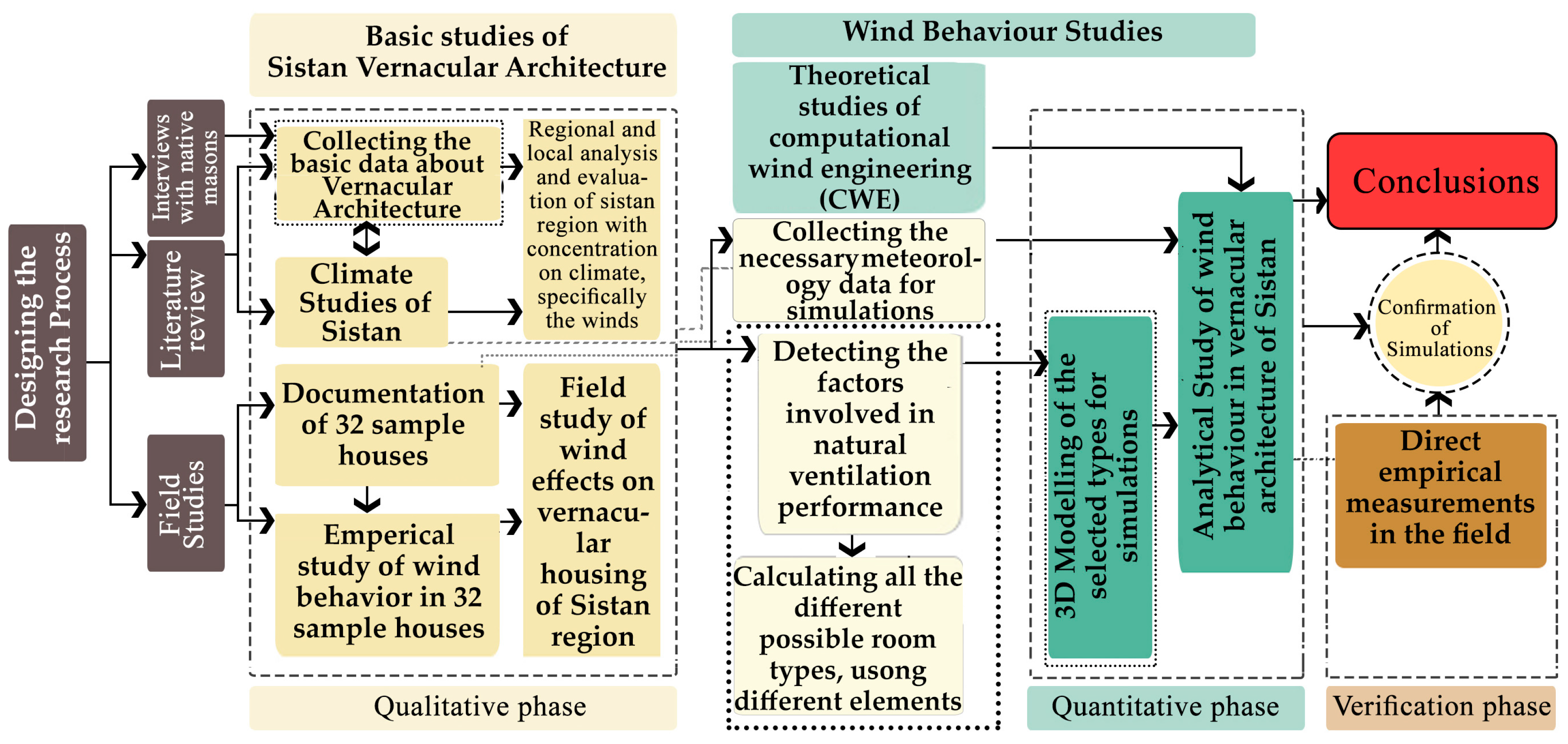

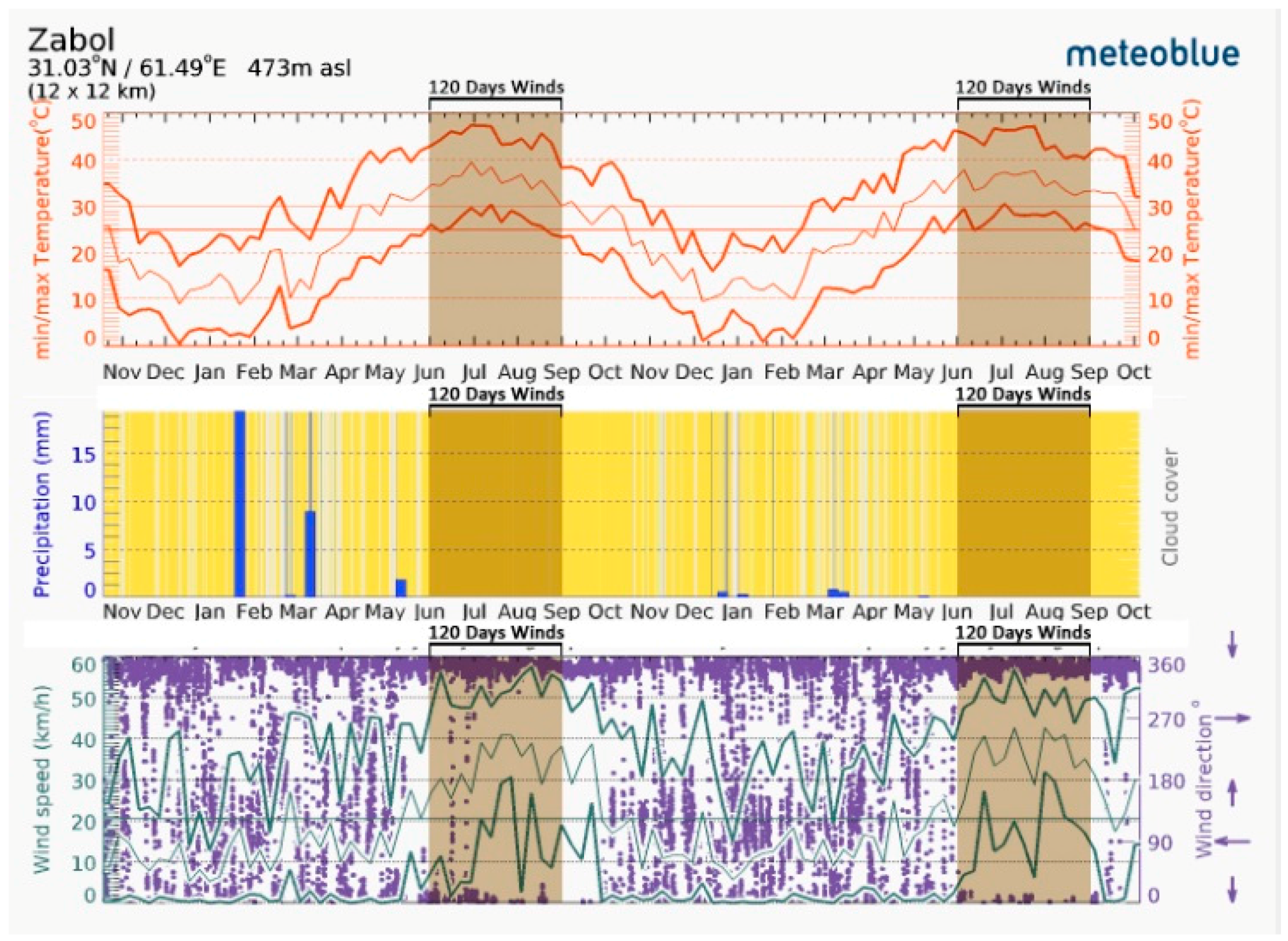
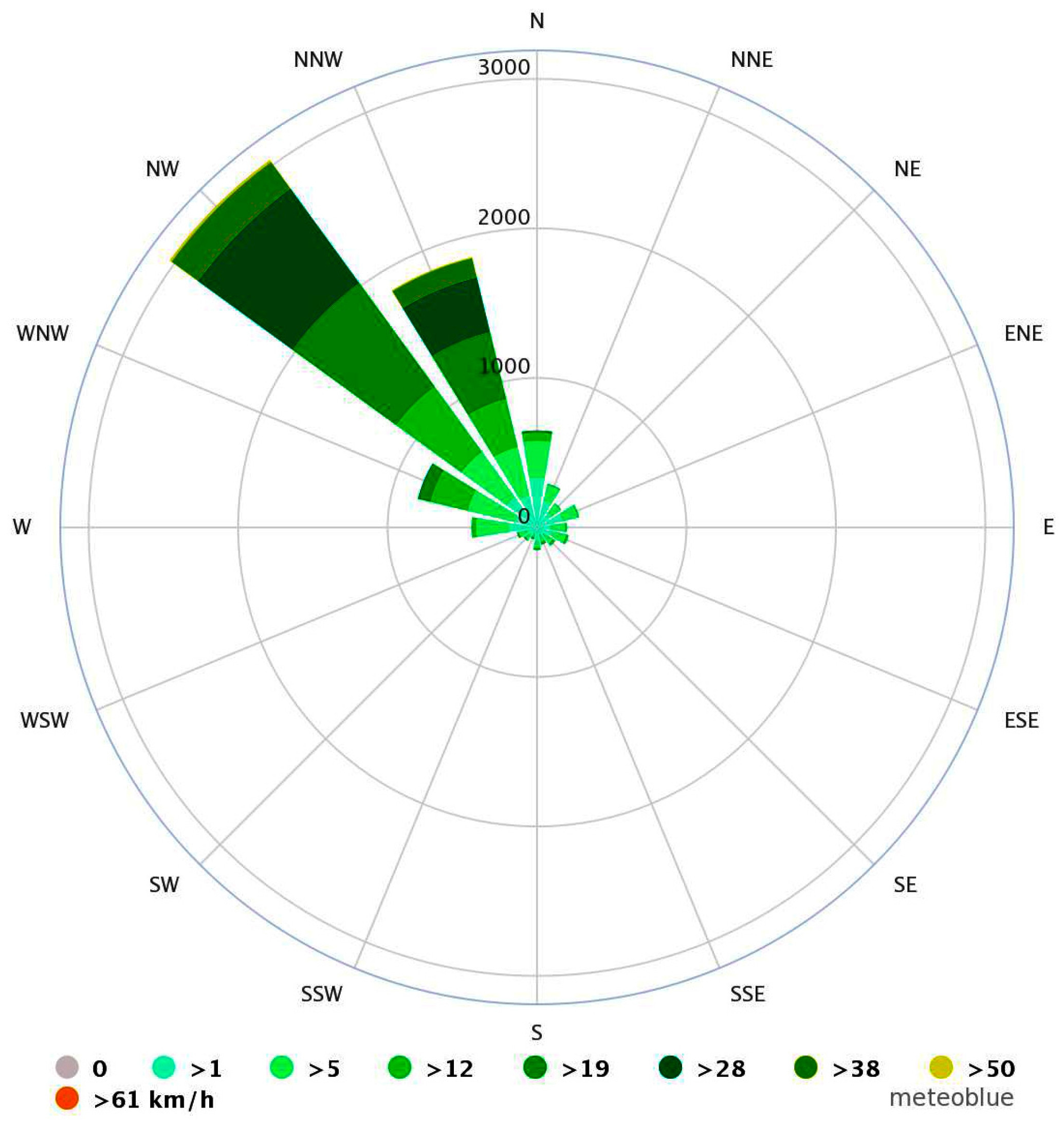

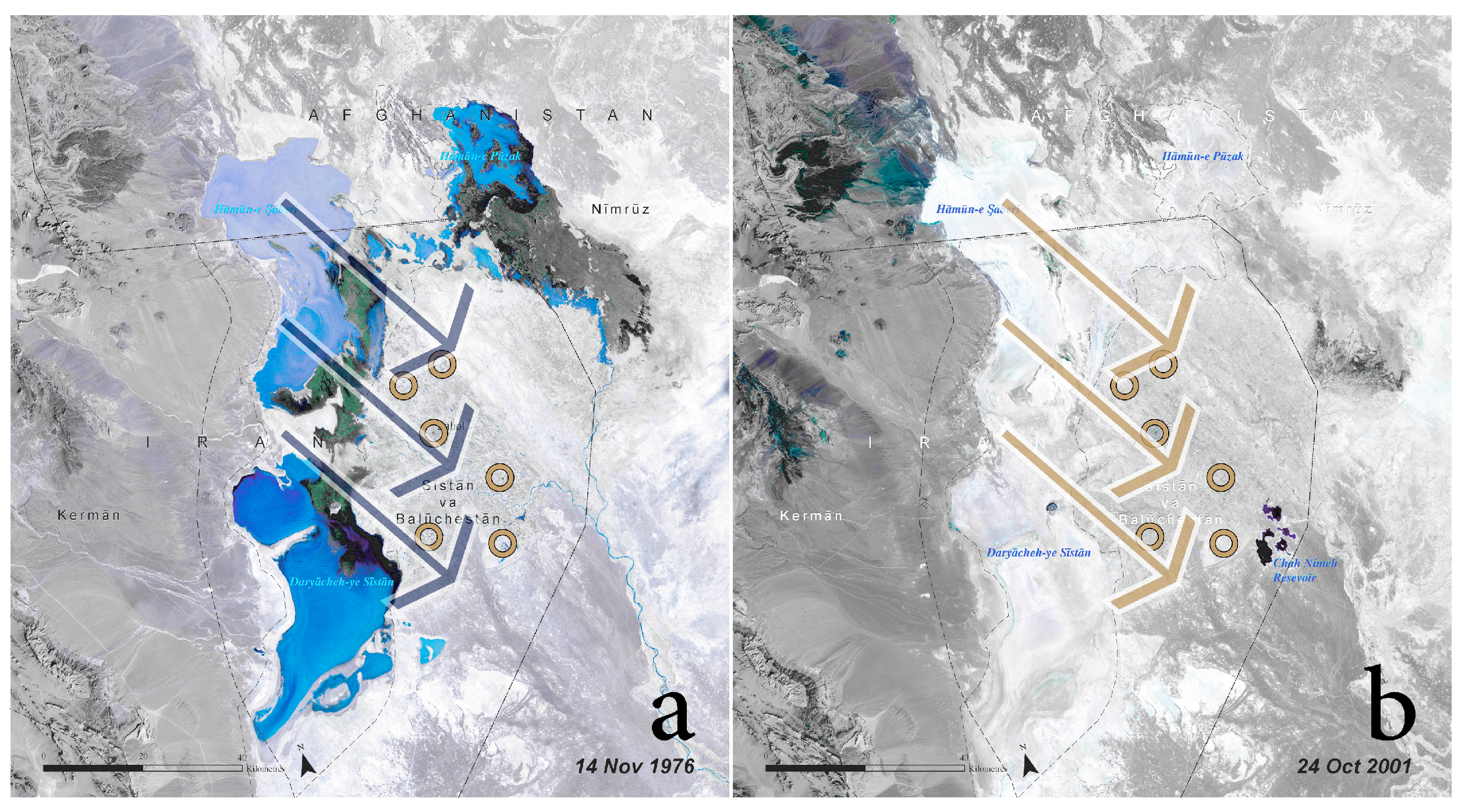
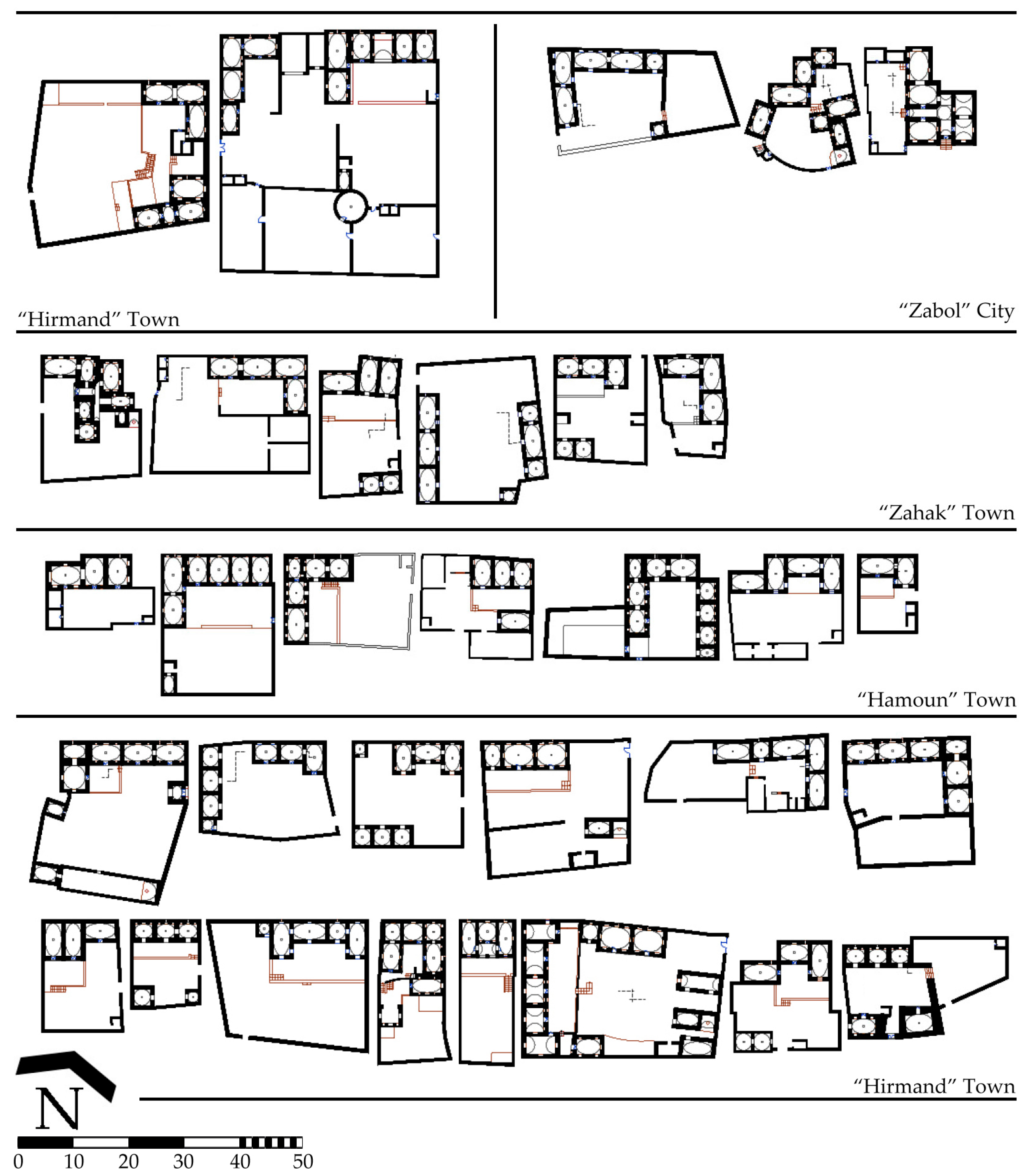
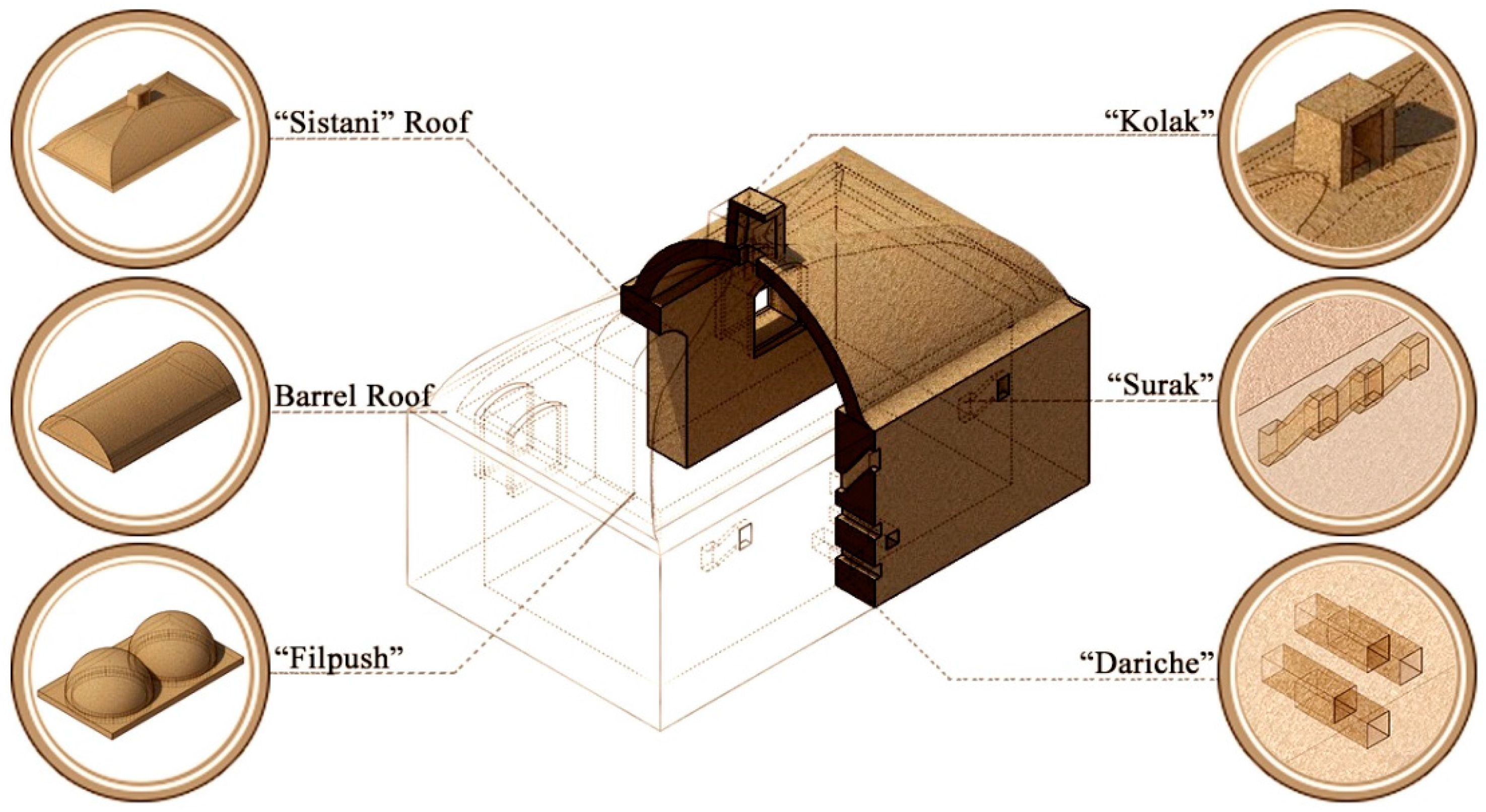





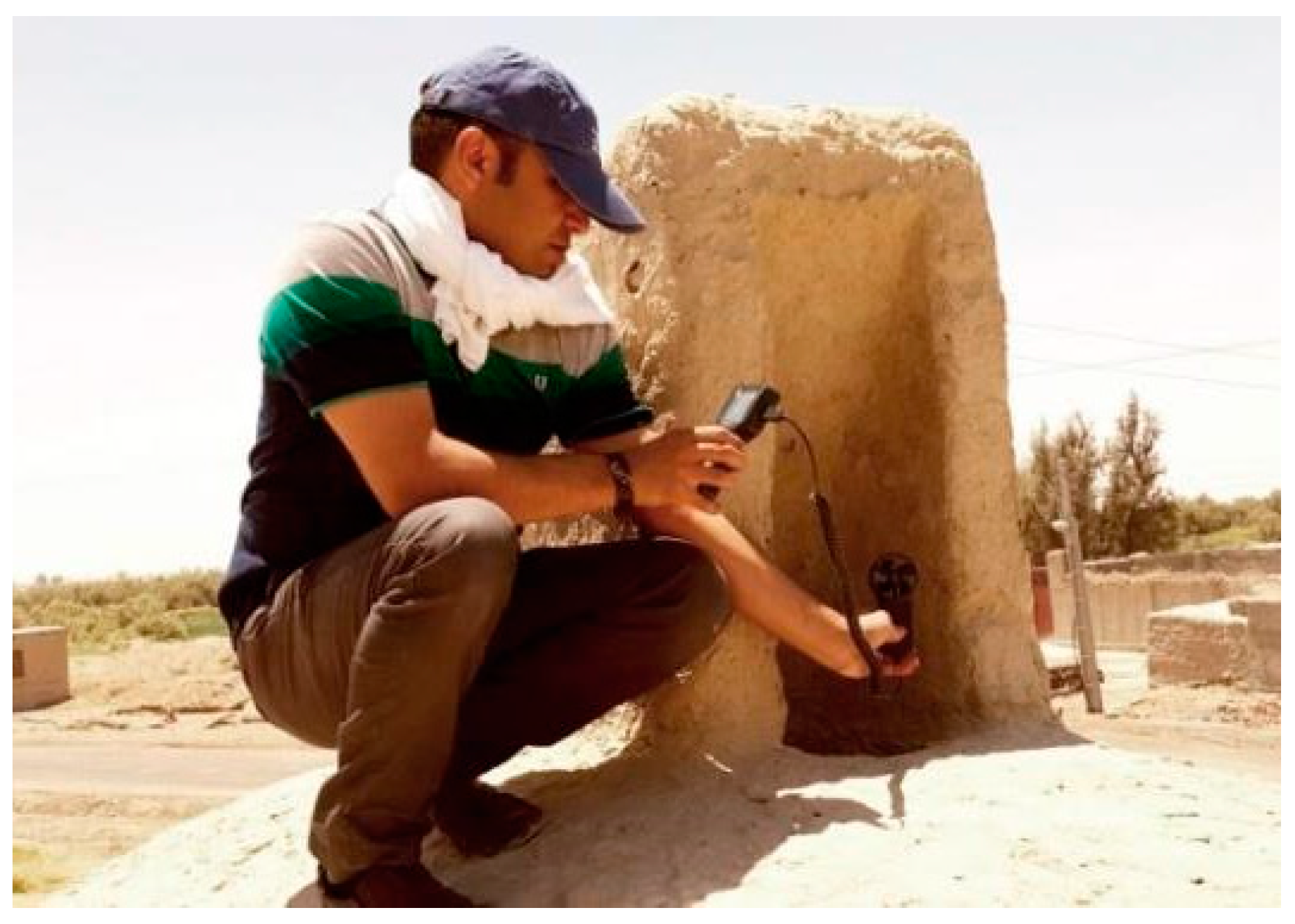
| City/Town | Dependent Villages | The Percent of Dependent Villages | Respective House Number for Each City or Town |
|---|---|---|---|
| “Zabol” City | 77 | 9.5% | 3 |
| “Zahak” Town | 148 | 19.7% | 6 |
| “Hamoun” Town | 160 | 19.8% | 7 |
| “Hirmand” Town | 305 | 27% | 12 |
| “Nimrouz” Town | 118 | 14% | 4 |
| Total | 808 | 100% | 32 |
| Living Rooms | |||||
| Room Count | Daricheh Count | Sorak Count | Kolak Count | Roof Count | Roof Percentage |
| 150 | 95 (63%) | 37 (24.5%) | 126 (85%) | Sistani = 125 | 83% |
| Filpush = 16 | ~11% | ||||
| Barrel = 9 | 6% | ||||
| Service Rooms | |||||
| Room Count | Daricheh Count | Sorak Count | Kolak Count | Roof Count | Roof Percentage |
| 36 | 0 | 0 | 25 (70%) | Sistani = 12 | 33% |
| Filpush = 18 | 50% | ||||
| Barrel = 6 | ~17% | ||||
| Category | Element | Photo | Construction Method | Illustration |
|---|---|---|---|---|
| Roofs | Sistani Roof |  Sistani roof, native roof of Sistan | Sistani roof is made of oblique arches built simultaneously on two sides of the roof which finally meet in the middle [11,47,48]. The volume underneath this roof is greater than any other roof in vernacular architecture of Iran which helps this roof hold a great volume of warm air underneath itself; this fact helps provide a better air-flow in the room and a more comfortable living environment. |  Sistani roof, construction method |
| Filpush Roof |  Filpush roof | Vaults with different heights are built on all corners until they all meet in the middle and the room is covered [11,47,48]. This roof can also hold a great amount of warm air underneath itself and help provide a more comfertable setting near the ground. |  Filpush roof, construction method | |
| Barrel Roof |  Barrel Vault | Barrel vaults are usually used in narrow rooms with great length. Building process starts from one side of the room and numerous individual arches are built side by side until the whole span is covered; then, sides of the vault are blocked by straight vertical walls (“Espa’ar” in native language) [11,47,52]. This roof can also hold a significant amount of warm air underneath itself and help provide a more comfertable setting near the ground. |  Barrel Vault, construction method | |
| Ventilator openings | Kolak |  Kolak ventilator openings, native wind-catcher of Sistan | Native one-sided wind-catcher of Sistan, built in the middle of the roof, facing the region’s prevalent wind (northwest to southeast) [48]. The curve form of the roof decreases the fraction and accelerates the wind towards the opening of the wind-catcher. This acceleration also causes the air pressure at the top of the dome to fall down, and therefore, air enters the room faster [21,53]. |  Kolak ventilator openings, construction method |
| Surak |  Surak ventilator openings | Canals in the walls, which are usually built in groups of three, located in the northwest walls. Two lids of each canal in two different sides of the wall are located in slightly different heights causing the wind enter the room obliquely and leave its contamination (especially sand) inside the canal before entering the room [11,46]. |  Surak ventilator openings, construction method | |
| Daricheh |  Daricheh ventilator openings | Darichehs are a group of canals built in the northwest walls. Two lids of each canal in two sides of the wall are located in the same height causing the wind to enter the room directly. Daricheh is located in the lower section of the wall near the ground creating the opportunity to make a stack of hay in front of it. The stack is sprayed by water and when the wind passes through it, gets cooled off and enters the room as a cool breeze [47,54,55]. |  Daricheh ventilator openings, dimensions | |
| Walls |  Adobe walls in Sistans vernacular architecture | The walls are all made of adobe. Standard adobe in vernacular architecture of Sistan is a 22 cm × 22 cm ingot. Walls are made of three rows of adobes which is 66 cm thick. The hot weather outside the building is hampered by the thickness of the walls as well as the low heat transfer coefficient of adobe [46,47,51]. These thick walls are a great contribution to natural ventilation efforts in the building and help maximize ventilation efficiency. |  Adobe Walls in Sistans vernacular architecture, dimension and heat hampering performance | |
| Room Number | Element | Plan and Orientation | 3D Section | |
|---|---|---|---|---|
| Compound Room Type 1 | ||||
| √ | Room 1 | Kolak |  |  |
| √ | Room 2 | |||
| √ | Room 1 | Surak | ||
| √ | Room 2 | |||
| √ | Room 1 | Dariche | ||
| √ | Room 2 | |||
| - | Room 1 | Window | ||
| - | Room 2 | |||
| Compound Room Type 2 | ||||
| √ | Room 1 | Kolak |  |  |
| √ | Room 2 | |||
| √ | Room 1 | Surak | ||
| - | Room 2 | |||
| √ | Room 1 | Dariche | ||
| √ | Room 2 | |||
| - | Room 1 | Window | ||
| √ | Room 2 | |||
| Compound Room Type 3 | ||||
| √ | Room 1 | Kolak |  |  |
| √ | Room 2 | |||
| - | Room 1 | Surak | ||
| - | Room 2 | |||
| √ | Room 1 | Dariche | ||
| - | Room 2 | |||
| - | Room 1 | Window | ||
| √ | Room 2 | |||
| Room Sample 1 | Room Sample 2 | ||
| Measurement Points | Measurement Points | ||
 Plan |  Section |  Plan |  Section |
| Wind speed | Wind speed | ||
| VA = 0 M/S | VD = 1.5 M/S–1.7 M/S | VA = 3.5 M/S–9 M/S | VE = 7 M/S–8 M/S |
| VB = 3.5 M/S–9 M/S | VE = 8 M/S–13 M/S | VB = 5 M/S–14 M/S | VF = 8 M/S–9 M/S |
| VC = 5 M/S–14 M/S | VF = 7 M/S–8 M/S | VC = 1.5 M/S–1.7 M/S | VG = 14 M/S–15 M/S |
| VD = 8 M/S–13 M/S | |||
© 2017 by the authors. Licensee MDPI, Basel, Switzerland. This article is an open access article distributed under the terms and conditions of the Creative Commons Attribution (CC BY) license (http://creativecommons.org/licenses/by/4.0/).
Share and Cite
Heidari, A.; Sahebzadeh, S.; Dalvand, Z. Natural Ventilation in Vernacular Architecture of Sistan, Iran; Classification and CFD Study of Compound Rooms. Sustainability 2017, 9, 1048. https://doi.org/10.3390/su9061048
Heidari A, Sahebzadeh S, Dalvand Z. Natural Ventilation in Vernacular Architecture of Sistan, Iran; Classification and CFD Study of Compound Rooms. Sustainability. 2017; 9(6):1048. https://doi.org/10.3390/su9061048
Chicago/Turabian StyleHeidari, Abolfazl, Sadra Sahebzadeh, and Zahra Dalvand. 2017. "Natural Ventilation in Vernacular Architecture of Sistan, Iran; Classification and CFD Study of Compound Rooms" Sustainability 9, no. 6: 1048. https://doi.org/10.3390/su9061048





